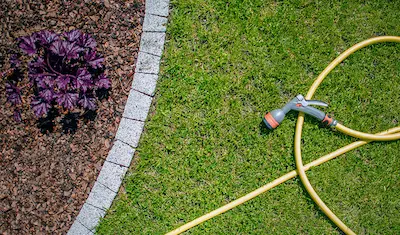
Like all living things, your lawn needs sunlight, food, and water in order to survive. While factors such as climate and soil conditions may cause variations with regards to the frequency and amount of water that is needed, the best time of day to water your lawn remains the same. Here are some helpful tips to keep your lawn looking its best, from the landscape experts at The Grounds Guys®.
What is the Best Time to Water Your Lawn?
While it is important to provide your lawn with adequate amounts of water, it is equally as important to water at the right time of day to maximize absorption and reduce the likelihood of disease or infestation. For best results, water your lawn in the early part of the day before temperatures or the wind start to pick up. Opt to have your watering completed by 10 a.m. to allow time for the water to penetrate the soil before evaporation can occur.
If you must water later in the day, choose a time between four and six p.m. to allow time for the grass to dry before nightfall, when the absence of sunlight and lower temperatures can result in a lawn that is wet for 12 to 15 hours, contributing to fungal or bacterial diseases.
How Long Should You Water Your Lawn?
Aim for an average of one inch of water per week, divided among two to three watering sessions during hotter weather. Under normal conditions, it takes approximately 30 minutes to deliver one-half inch of water. Slow and steady delivery allows the water to soak deep into the root system while allowing for proper airflow and drainage.
Watering Requirements for Different Lawn Types
The best time to water lawn varieties depends on a number of factors including which zone you reside in, the season, and the type of grass. Use these guidelines for best results:
Warm-Season Grasses
Warm-season grasses thrive in climates where temperatures are between 80 and 95 degrees and include varieties such as Zoysia, Bermuda, and St. Augustine. Continue to actively water as long as the grass is growing and requires regular mowing, keeping in mind that warm-season grasses may require less water than their counterparts.
Cool-Season Grasses
Cool-season grasses such as Kentucky bluegrass, fescues, and ryegrass are ideally found in northern climates with active growth well into the fall season. While evaporation rates may slow in cooler weather, continue to provide between one and one-and-a-half inches of water each week up until the first frost.
Lawn Watering Tips
- Don't overwater. Allow the lawn to dry out in between watering to establish a strong root system, which will kill the weeds and fungi.
- Raise your mower height. Cut higher during periods of excessive heat or drought to provide a shade canopy to protect the base of the grass.
- Make exceptions. Pay close attention to moisture levels around large trees where the water requirements may be higher, and water sloped areas more slowly to allow time for proper absorption.
- Check the soil. Use a screwdriver to check the soil during your first watering to determine how long it takes for the water to reach a depth of six inches, and set your sprinkler system accordingly.
A well-maintained deck can further enhance the beauty and functionality of your outdoor space. If your deck needs a fresh coat of paint or stain, contact the experts at Five Star Painting today. For all your landscape needs, including lawn care and maintenance, call The Grounds Guys at (888) 972-8063, or contact us online for a free estimate for commercial or residential landscape services.